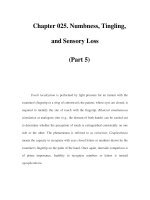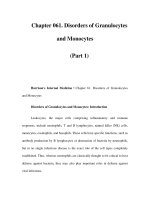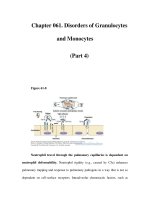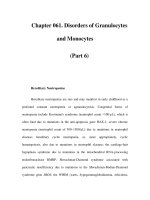Chapter 109. Disorders of Platelets and Vessel Wall (Part 5) ppt
Bạn đang xem bản rút gọn của tài liệu. Xem và tải ngay bản đầy đủ của tài liệu tại đây (13.86 KB, 5 trang )
Chapter 109. Disorders of Platelets
and Vessel Wall
(Part 5)
Laboratory Testing for HIT
HIT (antiheparin/PF4) antibodies can be detected using two types of assays.
The most widely available is an enzyme-linked immunoassay (ELISA) with
PF4/polyanion complex as the antigen. Since many patients develop antibodies but
do not develop clinical HIT, the test has a low specificity for the diagnosis of HIT.
This is especially true in patients who have undergone cardiopulmonary bypass
surgery, where approximately 50% of patients develop these antibodies
postoperatively. The other assay is a platelet activation assay that measures the
ability of the patients' serum to activate platelets in the presence of heparin in a
concentration-dependent manner. This test has lower sensitivity but higher
specificity than the ELISA. However, HIT remains a clinical diagnosis. The main
value in testing is in excluding the diagnosis with negative tests, particularly
ELISA.
Heparin-Induced Thrombocytopenia: Treatment
Early recognition is key in treatment of HIT, with prompt discontinuation
of heparin and use of alternative anticoagulants. Thrombosis is a common
complication of HIT, even after heparin discontinuation, and can occur in both the
venous and arterial systems. In patients diagnosed with HIT, imaging studies to
evaluate the presence of thrombosis (at least lower-extremity duplex dopplers) are
recommended. Patients requiring anticoagulation should be switched from heparin
to an alternative anticoagulant. The direct thrombin inhibitors (DTIs) argatroban
and lepirudin are effective in HITT. The DTI bivalirudin and the antithrombin-
binding pentasaccharide fondaparinux appear to be effective but are not yet
approved by the U.S. Food and Drug Administration (FDA) for this indication.
Danaparoid, a mixture of glycosoaminoglycans with anti-Xa activity, has been
used extensively for the treatment of HITT; it is no longer available in the United
States but is in other countries. HIT antibodies cross-react with LMWH, and these
preparations should not be used in the treatment of HIT.
Because of the high rate of thrombosis in patients with HIT, anticoagulation
should be strongly considered, even in the absence of thrombosis. In patients with
thrombosis, patients can be transitioned to warfarin, with treatment usually for 3–6
months. In patients without thrombosis, the duration of anticoagulation needed is
undefined. An increased risk of thrombosis is present for at least 1 month after
diagnosis; however, most thromboses occur early, and whether thrombosis occurs
later if the patient is initially anticoagulated is unknown. Options include
continuing anticoagulation until a few days after platelet recovery or for one
month. Introduction of warfarin alone in the setting of HIT or HITT may
precipitate thrombosis, particularly venous gangrene, presumably due to clotting
activation and severely reduced levels of proteins C and S. Warfarin should only
be started after alternative anticoagulation has been given for several days and the
prothrombotic state has lessened.
Immune Thrombocytopenic Purpura (ITP)
Immune thrombocytopenic purpura (ITP; also termed idiopathic
thrombocytopenic purpura) is an acquired disorder leading to immune-mediated
destruction of platelets and possibly inhibition of platelet release from the
megakaryocyte. In children it is usually an acute disease, most commonly
following an infection, and with a self-limited course. In adults it usually runs a
more chronic course. The exact nature of the immune dysfunction is generally not
known. ITP is termed secondary if it is associated with an underlying disorder;
autoimmune disorders, particularly systemic lupus erythematosis (SLE), and
infections, such as HIV and hepatitis C, are common causes. The association of
ITP with Helicobacter pylori infection is unclear.
ITP is characterized by mucocutaneous bleeding and a low, often very low,
platelet count, with otherwise normal peripheral blood cells and smear. Patients
usually present either with ecchymoses and petechiae, or with thrombocytopenia
incidentally found on a routine CBC. Mucocutaneous bleeding, such as oral
mucosa, gastrointestinal, or heavy menstrual bleeding, may be present. Rarely,
life-threatening bleeding, including in the central nervous system, can occur. Wet
purpura (blood blisters in the mouth) and retinal hemorrhages may herald life-
threatening bleeding.
Laboratory Testing in ITP
Laboratory testing for antibodies (serologic testing) is usually not helpful
due to the low sensitivity and specificity of the tests. Bone marrow examination
can be reserved for older adults (usually >60 years) or those who have other signs
or laboratory abnormalities not explained by ITP, or in patients who do not
respond to initial therapy. The peripheral blood smear may show large platelets,
with otherwise normal morphology. Depending on the bleeding history, iron
deficiency anemia may be present.
Laboratory testing is performed to evaluate for secondary causes of ITP and
should include testing for HIV infection and hepatitis C (and other infections if
indicated); serologic testing for SLE; serum protein electrophoresis and
immunoglobulin levels to potentially detect hypogammaglobulinemia, IgA
deficiency, or monoclonal gammopathies; and, if anemia is present, direct
antiglobulin testing (Coombs test) to rule out combined autoimmune hemolytic
anemia with ITP (Evans's syndrome).









